Wikipedia:Picture of the day/January 2007
|
Featured picture tools: |
These featured pictures, as scheduled below, appeared as the picture of the day (POTD) on the English Wikipedia's Main Page in January 2007. Individual sections for each day on this page can be linked to with the day number as the anchor name (e.g. [[Wikipedia:Picture of the day/January 2007#1]] for January 1).
You can add an automatically updating POTD template to your user page using {{Pic of the day}} (version with blurb) or {{POTD}} (version without blurb). For instructions on how to make custom POTD layouts, see Wikipedia:Picture of the day.
January 1

|
A honey bee extracts nectar from a flower using its proboscis. Tiny hairs covering the bee's body maintain a slight electrostatic charge, causing pollen from the flower's anthers to stick to the bee's hairs, allowing for pollination when the bee moves on to another flower. Photo credit: Jon Sullivan
Recently featured:
|
January 2

|
The obverse of a proof-quality Lincoln cent with cameo effect. This has been the United States one-cent coin since 1909. Among United States coins, there are more one-cent coins produced than any other denomination. The reverse has featured the Lincoln Memorial since 1959. When the Lincoln cent made its initial appearance, it marked a radical departure from the accepted styling of United States coins. A strong feeling had prevailed against using portraits, but public sentiment stemming from the 100th anniversary celebration of Abraham Lincoln's birth proved stronger than the long-standing prejudice. Photo credit: U.S. Mint
Recently featured:
|
January 3

|
The Clock Tower is a turret clock structure at the north-eastern end of the Houses of Parliament building in Westminster, London. It is colloquially and popularly known as Big Ben; however this name actually belongs to the clock's main bell. It was raised as a part of Charles Barry's design of a new palace, after the old one was destroyed by fire. The tower is designed in the Victorian Gothic style, and is 96.3 metres (316 feet) high. Photo credit: Diliff
Recently featured:
|
January 4
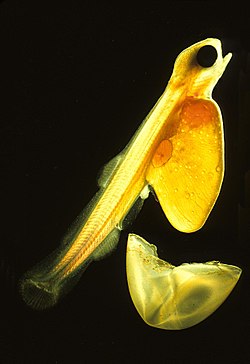
|
An Atlantic salmon (Salmo salar) egg hatching. The Alevin (larva) has grown around the remains of the yolk sac - visible are the arteries spinning around the yolk and little oildrops, also the gut, the spine, the main caudal blood vessel, the bladder and the arcs of the gills. In about 24 hours it will be a fry without yolk sac. Photo credit: Uwe Kils
Recently featured:
|
January 5

|
The Magellanic penguin (Spheniscus magellanicus) is a South American penguin, breeding in coastal Argentina, Chile and the Falkland Islands, with some migrating to Brazil. It is the most numerous of the Spheniscus penguins. Its nearest relatives are the African Penguin, the Humboldt Penguin and the Galapagos Penguin. The main threat to this species is oil pollution which kills more than 20,000 adults and 22,000 juveniles every year off the coast of Argentina. Photo credit: NASA
Recently featured:
|
January 6
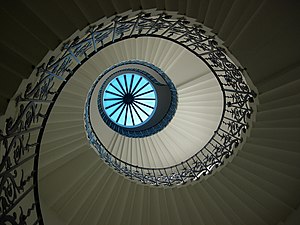
|
The Tulip Stairs and lantern, as seen from below, of the Queen's House in Greenwich, England. Designed by Inigo Jones, the stairs are the first centrally unsupported stairs constructed in England. The stairs are supported by a combination of support by cantilever from the walls and each stair resting on the one below. The first reference to the iron balustrade design as 'tulips' was in 1694 and the name 'Tulip Stairs' dates to the 18th century. Photo credit: Mcginnly
Recently featured:
|
January 7
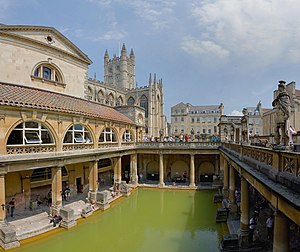
|
The Great Bath of the Roman Baths in Bath, England, with Bath Abbey in the background. The complex, a grade I listed building, was constructed during Roman Britain, during which time the town was known as Aquae Sulis. It was rediscovered in the 18th century and, as well as being a major archaeological find, it has become one of the city's main attractions. The entire structure above the level of the pillar bases is a later reconstruction. Photo credit: Diliff
Recently featured:
|
January 8

|
An animation showing how an obliquely cut torus reveals a pair of circles, known as Villarceau circles, named after the French astronomer and mathematician Yvon Villarceau. The circles have no known practical application, but are merely a curious and somewhat unexpected characteristic of the torus. Animation credit: Kieff
Recently featured:
|
January 9

|
The Treasury of Athens is a building at Delphi, the holiest of Ancient Greek sites and shrine to the god Apollo. It was built to commemorate the Athenians' victory at the Battle of Marathon. It is one of a number of such treasuries, built by the various states—those overseas as well as those on the mainland—to commemorate victories and to thank the oracle for advice important to those victories. The Athenians had previously been given the advice by the oracle to put their faith in their "wooden walls" – taking this advice to mean their navy, they won a famous battle at Salamis. Photo credit: Sam Korn
Recently featured:
|
January 10

|
A riffle shuffle, the most common shuffling technique, being performed during a game of poker. Shuffling is a procedure used to randomize a deck of playing cards to provide an element of chance in card games. It is often followed by a cut, to ensure that the shuffler has not manipulated the outcome. Photo credit: Johnny Blood
Recently featured:
|
January 11

|
A diagram of the basic morphology of a female dragonfly, showing detailed external structure and organisation. The wings in the diagram are raised higher than is usual in most dragonflies. The wings are in an 'inspection' position to allow a clearer view of the body. Generally both sets of wings are held relatively flat and horizontally against the body. This raised position is more common with a dragonfly in flight. The wings have been shown solely to give a sense of proportion. Diagram credit: WikipedianProlific/Gustavb/Andrew c
Recently featured:
|
January 12
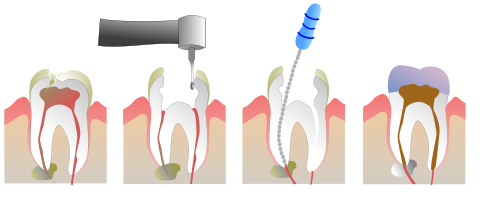
|
|
In dentistry, a pulpectomy is an endodontic treatment to cure an infection of the root canal. This illustration shows a cross section through the tooth at various stages of the procedure; unhealthy tooth, drilling, filing with endofile, rubber filling and crown. Illustration credit: Jeremy Kemp
Recently featured:
|
January 13
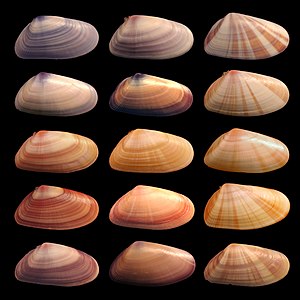
|
Individuals in the mollusk species Donax variabilis show diverse coloration and patterning in their phenotypes. The phenotype of an individual organism is either its total physical appearance and constitution or a specific manifestation of a trait, such as size, eye color, or behavior that varies between individuals. Phenotype is determined to a large extent by genotype and influenced by environmental factors. Early geneticists were able to trace inheritance patterns without any knowledge of molecular biology. Photo credit: Debivort
Recently featured:
|
January 14

|
Victoria Crater, an impact crater at Meridiani Planum, near the equator of Mars. The crater is approximately 800 meters (half a mile) in diameter. It has a distinctive scalloped shape to its rim, caused by erosion and downhill movement of crater wall material. Layered sedimentary rocks are exposed along the inner wall of the crater, and boulders that have fallen from the crater wall are visible on the crater floor. The floor of the crater is occupied by a striking field of sand dunes. The Mars rover Opportunity can be seen in this image, at roughly the "ten o'clock" position along the rim of the crater. Photo credit: Mars Reconnaissance Orbiter
Recently featured:
|
January 15

|
The pennant coralfish (Heniochus acuminatus) is a tropical fish of the family Chaetodontidae found in the Indian and Pacific oceans in reef settings. It is commonly sold for marine aquariums as an alternative to the Moorish idol, which are considered to be nearly impossible for most hobbyists to keep. Photo credit: Fir0002
Recently featured:
|
January 16
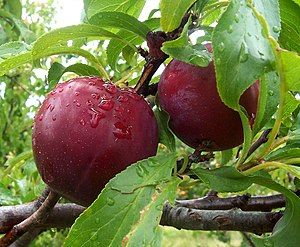
|
The plum is a stone-fruit tree in the genus Prunus. Its fruit is sweet, juicy and edible, and it can be eaten fresh, or dried, in which case they are known as prunes. The plum blossom, along with the peony, are considered traditional floral emblems of China. Photo credit: Fir0002
Recently featured:
|
January 17

|
The Common Raccoon (Procyon lotor) is a widespread, medium-sized, omnivorous mammal of North America. It has black facial colorings around the eyes, and has a bushy tail with light and dark alternating rings. The coat is a mixture of gray, brown, and black fur. The characteristic eye colorings make the animal look like it is wearing a "bandit's mask," which has enhanced the animal's reputation for mischief, vandalism, and thievery. Photo credit: Darkone
Recently featured:
|
January 18
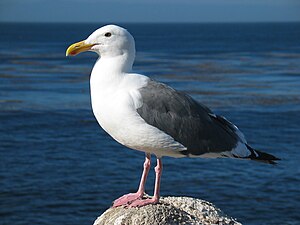
|
The Western Gull (Larus occidentalis) is a large white-headed gull that lives on the western coast of North America. It is a large gull, around 60 cm long with a white head and body, and gray wings. It has a yellow bill with a red subterminal spot (this is the small spot near the end of the bill that chicks peck in order to stimulate feeding). Photo credit: Daniel Schwen
Recently featured:
|
January 19
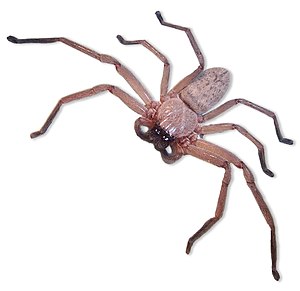
|
Huntsman spiders are a common group of spiders found in Australia, New Zealand, and many other tropical and semi-tropical areas of the world. Huntsmen do not build webs but forage for food - mostly insects and other invertebrates. They do bite if provoked, but the victim will suffer only minor swelling and localised pain, recovering in a day or so. Photo credit: Fir0002
Recently featured:
|
January 20

|
|
An animated image showing the definition of pi. A number line is marked off by a circle of unit diameter. Starting from zero, the circle "unrolls" its circumference. At one full turn, the unrolled circumference has extended to the point we call π. This number is real but irrational, transcendental, and cannot be constructed with compass and straightedge. Animation credit: John Reid
Recently featured:
|
January 21
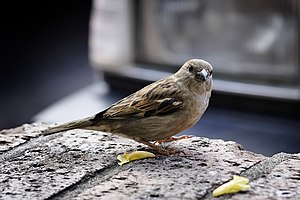
|
The House Sparrow (Passer domesticus, female shown here) is a member of the Old World sparrow family Passeridae. It occurs naturally in most of Europe and much of Asia, but has been introduced to most other parts of the world. Despite being so common, it is often confused with the smaller and slimmer Tree Sparrow. Photo credit: Fir0002
Recently featured:
|
January 22
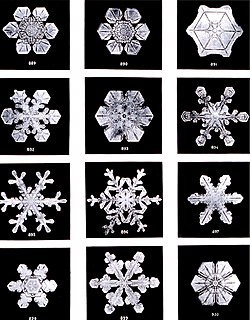
|
Plate XIX of "Studies among the Snow Crystals ... " by Wilson Bentley (1902), the first person known to photograph snowflakes. He did so by catching an individual snowflake on a blackboard, rushing it onto some black velvet, which he would then photograph using a bellows camera he had attached to a microscope. His first photograph of a snowflake was on January 15, 1885 and he would capture over 5000 images of crystals in his lifetime. Bentley also photographed all forms of ice and natural water formations including clouds and fog. He was the first American to record raindrop sizes and was one of the first cloud physicists. Photo credit: Wilson Bentley
Recently featured:
|
January 23

|
Vitrification is a process of converting a material into a glass-like amorphous solid which is free of any crystalline structure, either by the quick removal or addition of heat or by mixing with an additive. In this photo, nuclear waste has been combined with glass-forming materials, vitrified, and is being poured into a container, after which it will be sealed. The final waste form resembles obsidian and is a non-leaching, durable material that effectively traps the waste inside. The waste can be stored for relatively long periods in this form without concern for air or groundwater contamination. Photo credit: Pacific Northwest National Laboratory
Recently featured:
|
January 24

|
The Blue Jay (Cyanocitta cristata) is a North American jay which can be found over a very large area of the eastern side of the continent. It is mainly a bird of mixed woodland, but also of parks and gardens in some towns and cities. Its food is sought both on the ground and in trees and includes virtually all known types of plant and animal sources. Photo credit: Mdf
Recently featured:
|
January 25

|
|
A stitched panorama of a canal in the city of Amsterdam, the capital of the Netherlands. A series of concentric, semi-circular canals ("grachten") were dug around the old city centre in the 17th century, along which houses and warehouses were built. The canals still define Amsterdam's layout and appearance today. Photo credit: Diliff
Recently featured:
|
January 26
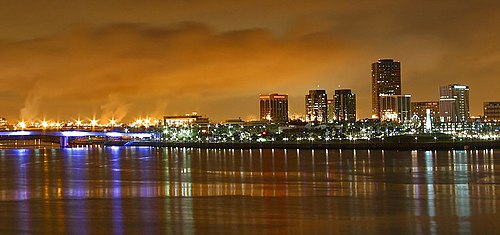
|
|
Downtown Long Beach, California at night, as seen across Queensway Bay from the RMS Queen Mary, with the Queensway Bay Bridge on the left. This portion of Long Beach is the home of most of the city's major tourist attractions and municipal services. It is also the location for numerous businesses. There are many hotels and restaurants in the area that serve locals, tourists, and convention visitors. Photo credit: Jon Sullivan
Recently featured:
|
January 27
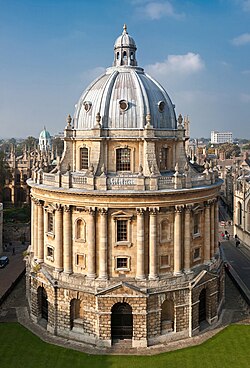
|
A stitched image of the Radcliffe Camera in Oxford, England, as seen from the tower of the Church of St Mary the Virgin. The building, often abbreviated as 'Rad Cam', was built by James Gibbs in 1737–1749 to house the Radcliffe Science Library. After the Radcliffe Science Library moved into another building, the Radcliffe Camera became a reading room of the Bodleian Library. Photo credit: Diliff
Recently featured:
|
January 28

|
An example of contre-jour (French for "against the day light") photography, when the camera is pointing towards the light source. In this picture, the light reflecting off the ground within the tunnel gives depth to an otherwise two-dimensional image. Image taken in São Martinho do Porto, west coast of Portugal, 1968. Photo credit: Joaquim Alves Gaspar
Recently featured:
|
January 29

|
The Barred Owl (Strix varia), commonly known as the hoot owl, is a large typical owl. Its breeding habitat is dense woods across Canada, the eastern United States and south to Central America. They hunt at dawn, dusk, or night, by waiting on a high perch or flying through the woods and swooping down on prey. They mainly eat small mammals, such as mice and rabbits, and also small birds. Photo credit: Mdf
Recently featured:
|
January 30

|
The Mexican redknee tarantula (Brachypelma smithi) is a species of terrestrial tarantula native to Mexico, but might be found in small numbers in neighboring countries. They are among the most popular tarantulas available in the pet trade, due to their impressive size and striking coloration. An adult female has a body roughly 10 cm (4 in) long, with a legspan of 15-18 cm (6-7 in), and a weight of approximately 15-16 g (0.7 oz). Photo credit: Fir0002
Recently featured:
|
January 31

|
Gordon Parks' most famous photograph, American Gothic, Washington, D.C., which was the first one he took during his stint working for the Farm Security Administration. This portrait of government cleaning woman Ella Watson shows her standing stiffly in front of an American flag with a broom in her right hand and a mop in the background. Its polemic nature and its duality of victim and survivor gave it a resonance that deeply affected many of its viewers. Photo credit: Gordon Parks
Recently featured:
|
Picture of the day archives and future dates
